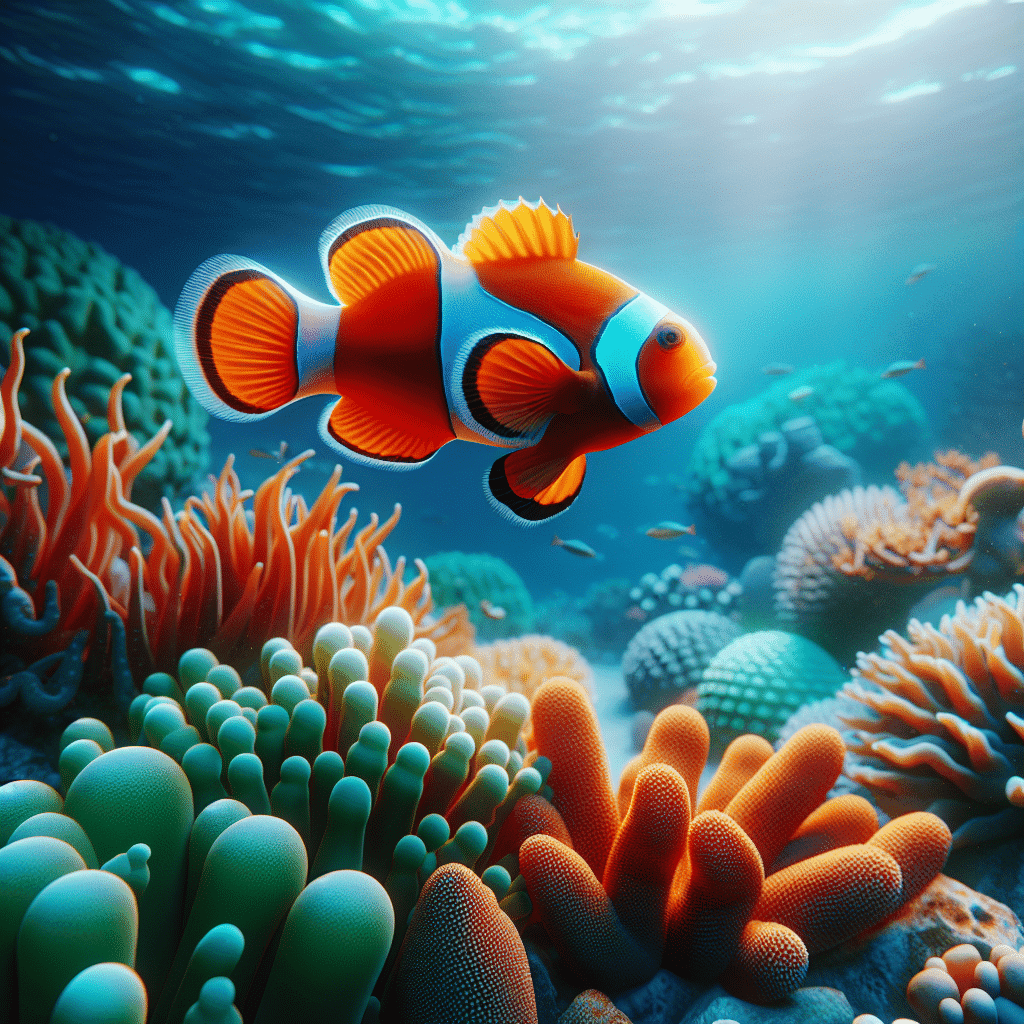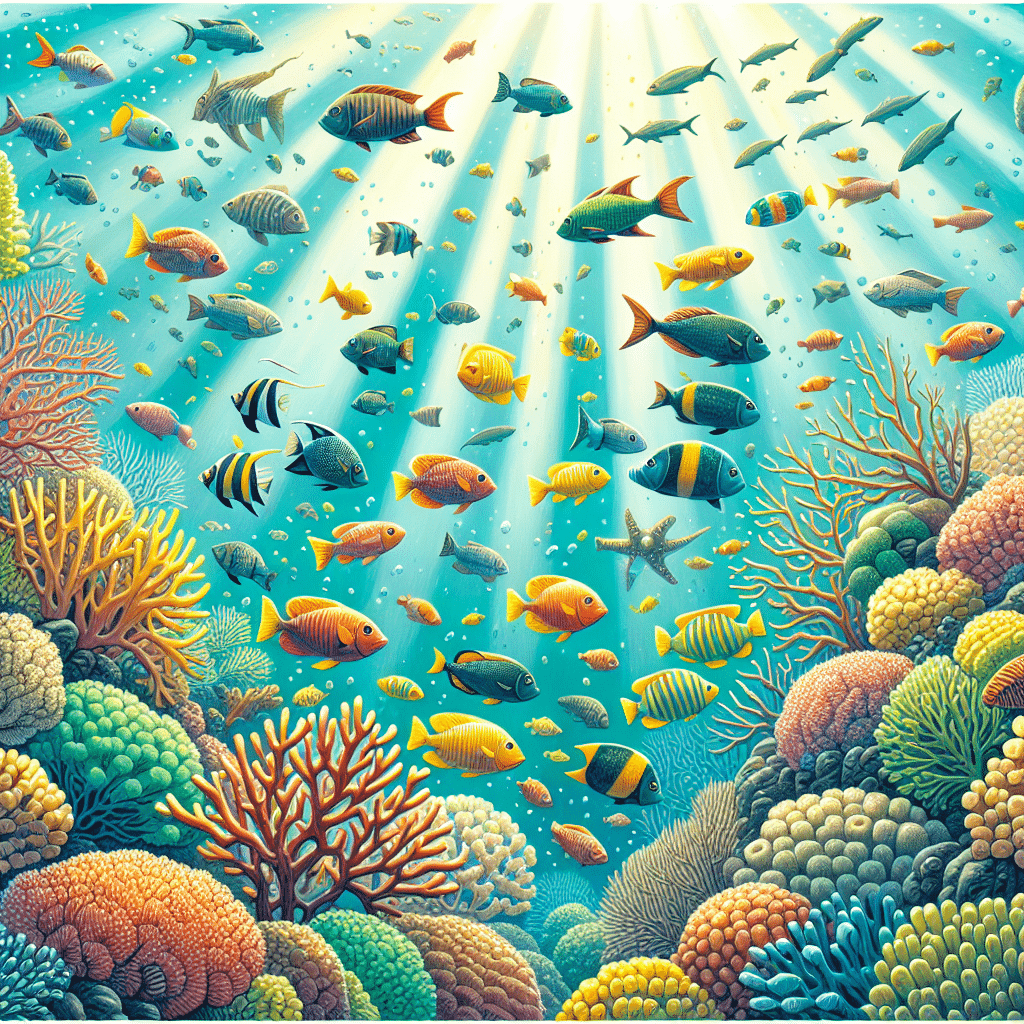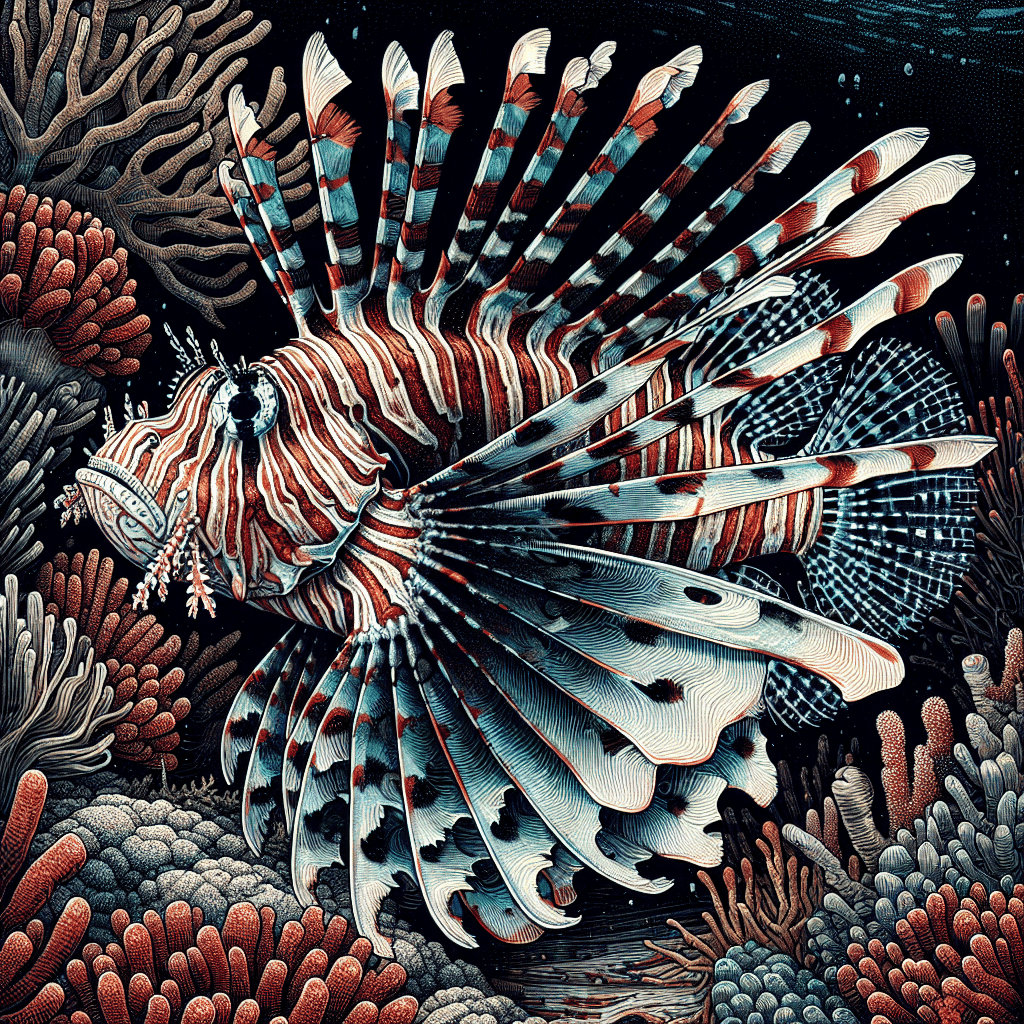Clownfish and Anemones
Symbiotic Relationship with Anemones
I find the relationship between clownfish and sea anemones fascinating. Clownfish have a mutualistic bond with anemones in the warm waters of the Pacific and Indian Oceans. This relationship works like a well-oiled machine. The clownfish secrete a special substance that prevents the anemones’ nematocysts, or stinging cells, from firing. This allows them to swim among the anemone’s tentacles without getting hurt, creating a safe haven for themselves. In return, clownfish attract other fish into the anemone’s grasp, which then become meals for the anemone.
Here’s a quick summary of the mutual benefits:
| Clownfish Benefits | Anemone Benefits |
|---|---|
| Safe shelter from predators | Access to prey attracted by the clownfish |
| Fertilization from clownfish waste | Protection from predators and parasites |
Importance of Symbiosis in Ecosystems
Understanding symbiotic relationships, like that of clownfish and sea anemones, is crucial for grasping ecosystem health. Coral reefs, where these relationships thrive, face significant threats. Increasing ocean temperatures have led to coral expelling the algae that live within them, resulting in coral death. This loss of symbiosis indicates declining coral health, which can have cascading effects on marine biodiversity.
The relationship between clownfish and anemones is an example of how interconnected marine life is. Clownfish not only provide food and protection for the anemones but also help maintain the overall health of the reef ecosystem. By studying these interactions, we can better understand the impacts of human activities on marine environments and find ways to protect them.
In my experience as a hobbyist, it’s essential to appreciate these natural relationships when setting up a reef tank. Having clownfish and anemones in your aquarium not only adds beauty but also mimics the natural interactions that are vital for the health of marine ecosystems. For more information on other marine species to consider in your tank, check out our articles on marine fish and specific species like tangs and butterfly fish.
Clownfish Diet
Understanding what clownfish eat is essential for keeping them healthy and happy in my reef tank. They have specific dietary needs that vary between their wild habitat and captivity.
Wild Clownfish Diet
In the wild, clownfish are omnivores. They mainly feed on zooplankton, copepods, larvae, fish eggs, small shrimp, and algae. Their diet is closely linked to their habitat in the Indian Ocean, where they maintain a symbiotic relationship with anemones, which provide them protection and a place to find food (FantaSEA Aquariums).
| Food Source | Description |
|---|---|
| Zooplankton | Tiny floating organisms |
| Copepods | Small crustaceans |
| Fish Eggs | Eggs laid by other fish |
| Small Shrimp | Small marine shrimp |
| Algae | Plant material found in reefs |
Feeding Clownfish in Captivity
When it comes to feeding clownfish in captivity, I like to provide a varied diet to ensure they get all the necessary nutrients. High-quality marine pellets or flakes are great staples, along with frozen foods like mysis shrimp, cyclops, and brine shrimp. Live foods such as brine shrimp also add variety and excitement to their diet. Additionally, I can offer vitamin-soaked freeze-dried foods and seaweed sheets (nori) to round things out.
| Food Type | Example | Frequency |
|---|---|---|
| Marine Pellets/Flakes | High-quality brands | Daily |
| Frozen Foods | Mysis, Cyclops, Brine | Daily |
| Live Food | Brine Shrimp | Occasional |
| Seaweed Sheets (Nori) | Dried seaweed | 1-2 times a week |
| Freeze-Dried Foods | Vitamin-soaked options | 1-2 times a week |
It’s recommended to feed clownfish once a day, but if I plan to breed them, increasing the frequency to two or three times a day for juvenile specimens is beneficial.
A common method I use to determine the right amount of food is the eyeball method. This involves feeding about the same amount as the size of the clownfish’s eye per day. I need to be cautious about overfeeding, as it can lead to water quality issues in my tank (FantaSEA Aquariums). Keeping an eye on their feeding habits helps ensure my clownfish thrive!
Feeding Guidelines
Taking care of my clownfish means paying attention to their feeding needs. Proper feeding is essential for their health and overall well-being. Here’s what I’ve learned about feeding frequency and the importance of monitoring the quantity of food.
Feeding Frequency
For my clownfish, I typically feed them once a day. However, if I’m planning to breed them, I’ll increase the frequency to two or three times a day, especially for juvenile clownfish. This helps ensure that they get the right nutrients during their growth stages and supports their reproductive health.
| Fish Age | Recommended Feeding Frequency |
|---|---|
| Juvenile | 2-3 times a day |
| Adult | Once a day |
Quantity and Overfeeding Risks
When it comes to how much to feed my clownfish, I often use the “eyeball method.” This involves estimating the amount of food based on the size of their eye—essentially, I feed them about that much food each day. This method helps prevent overfeeding, which can lead to poor water quality in the tank.
Overfeeding is a common mistake among hobbyists. It can cause waste buildup, leading to an increase in ammonia levels and harmful conditions for my fish. Here’s a quick reminder of the risks of overfeeding:
| Overfeeding Risks | Description |
|---|---|
| Poor Water Quality | Increased ammonia levels can harm fish health. |
| Health Issues | Obesity and related diseases may develop. |
| Algae Blooms | Excess food can lead to excessive algae growth. |
Maintaining a balanced feeding routine is crucial for the health of my clownfish. By monitoring their feeding frequency and the quantity of food, I can ensure they thrive in their environment. For more information on the care of other marine fish, check out our articles on marine fish like the ocellaris clownfish or goby.
Clownfish Stripes
The stripes on clownfish are not just for show; they play a significant role in identification and social interactions. As a fish tank hobbyist, understanding these stripes can enhance my appreciation of these fascinating creatures.
Stripe Variation in Species
Clownfish come in several species, each with a unique stripe pattern. The number of stripes can range from zero to three, and the organization of these stripes varies. For instance, two-striped species typically lose the stripe closest to the tail, while one-striped species keep the head stripe but lose the trunk and tailfin stripes (Earth.com).
Here’s a quick overview of the stripe variations:
| Clownfish Species | Number of Stripes | Stripe Characteristics |
|---|---|---|
| Amphiprion ocellaris | Three | Retains all stripes |
| Amphiprion frenatus | One | Retains head stripe, loses others |
| Two-striped species | Two | Loses tail stripe |
| Stripe-less species | Zero | Completely lacks stripes |
The different stripe patterns may help clownfish recognize each other, especially during mating rituals. These markings are more than aesthetic; they are integral to their social structure.
Stripe Development and Evolution
The development of stripes in clownfish begins shortly after birth. Interestingly, the larvae of two well-known species, Amphiprion ocellaris and Amphiprion frenatus, have no stripes at all right after hatching. They develop their stripes on the head and trunk simultaneously as they grow.
As clownfish mature, some species may lose stripes altogether, reflecting a pattern observed in evolutionary history. The ancestors of modern clownfish possessed three white stripes. Over time, as species evolved, some lost their stripes, a phenomenon that mirrors the stripe development in individual fish today (Earth.com).
This evolutionary process shows a remarkable similarity between the loss of stripes and the individual stripe development, providing insights into how these traits may have evolved over generations.
Understanding clownfish stripes enhances my knowledge and appreciation of these vibrant fish, making them even more enjoyable to care for in my reef tank. For more information on different types of marine fish, check out our section on marine fish.
Reproduction and Behavior
Mating and Reproduction
When it comes to clownfish, their mating process is quite fascinating. Clownfish are protandrous hermaphrodites, meaning they are all born male and can change to female later in life. In a group of clownfish, the largest individual is the female, while the second largest is the breeding male. The smaller fish are typically non-breeding males. If the female dies, the largest male will transform into female, and the next largest male will take over as the breeding male.
Clownfish exhibit a strict dominance hierarchy within their social groups. The mating behavior consists of external fertilization, where the female lays eggs and the male fertilizes them. Interestingly, clownfish can lay eggs at any time of the year. After the eggs are laid, the male takes the responsibility of guarding them until they hatch, ensuring their safety from potential threats. The male clownfish is the primary caretaker, although the female may assist occasionally.
| Clownfish Reproductive Roles | Description |
|---|---|
| Female | Largest fish, lays eggs |
| Breeding Male | Second largest, fertilizes eggs |
| Non-Breeding Males | Smaller, do not reproduce |
Social Structure and Communication
Clownfish live in social groups that typically consist of one dominant female, a dominant male, and several smaller males. Communication among clownfish is quite unique, as they make popping and clicking noises to interact with each other. This vocal communication helps establish their social structure and reinforces the dominance hierarchy (Great Barrier Reef Foundation).
The dominant male plays a crucial role in ensuring its position within the group, often by claiming the best feeding opportunities. If the dominant female passes away, the dominant male will permanently transition into a female, while the largest of the smaller males will rise to become the new dominant male. This intriguing social structure not only helps maintain order but also ensures the survival of the group.
Clownfish also have a symbiotic relationship with sea anemones, which enhances their social dynamics. The clownfish find protection among the anemones’ tentacles, while the clownfish provide food and help rid the anemones of parasites (Blue Reef Aquarium). This mutualistic relationship is vital for the health and safety of both species, showcasing the complexity of their interactions in the reef ecosystem.
If you’re keen on learning more about different marine species, check out articles on marine fish or specific types like tangs and triggerfish.
Conservation and Trade
Trade Impact on Populations
Clownfish are popular in the aquarium trade, making up approximately 43% of the global marine ornamental trade. However, this popularity comes with significant consequences for their populations. Approximately 75% of clownfish are captured from the wild, which can lead to reduced population density in areas that are heavily exploited (Great Barrier Reef Foundation). While clownfish are not currently considered highly threatened, localized declines in their populations have been observed due to capture for the marine ornamental trade.
To mitigate these impacts, public aquaria and captive-breeding programs have become essential. These initiatives not only help sustain clownfish populations but also provide an economically feasible alternative for the trade. Captive-bred clownfish account for about 25% of the global trade, which is a positive step toward reducing reliance on wild populations.
Conservation Status and Threats
While clownfish are generally not highly threatened, their conservation status is still a concern due to several factors. The significant capture from the wild poses a potential risk to their populations, especially in regions where they are extensively harvested. This can lead to decreased genetic diversity and resilience in affected areas.
Other threats include habitat destruction, particularly the degradation of coral reefs, which are crucial for their survival. As reef tank and fish tank hobbyists, it’s essential to be mindful of the impact of our hobby on clownfish populations and their habitats. Supporting sustainable practices and choosing captive-bred fish can contribute positively to the conservation of these fascinating creatures.
| Factor | Impact on Clownfish |
|---|---|
| Marine Ornamental Trade | 43% of global trade, 75% from the wild |
| Habitat Destruction | Degradation of coral reefs |
| Captive Breeding | 25% of trade is sustainable |
By understanding the trade impacts and conservation status of clownfish, I can make informed decisions that benefit both my aquarium and the environment. For more information on other marine fish, check out our articles on marine fish, tangs, and triggerfish.
Habitat and Species Diversity
Understanding the natural habitat and species diversity of clownfish is crucial for anyone interested in keeping them in their reef tank. These vibrant little fish not only add color but also bring unique characteristics to the aquatic environment.
Natural Habitat of Clownfish
Clownfish thrive in warm waters, primarily found in the Indian Ocean, including the Red Sea and the Pacific Ocean. They typically inhabit sheltered reefs or lagoons where they form a symbiotic relationship with anemones. This relationship is mutually beneficial: the anemones provide protection from predators and food scraps, while the clownfish help lure prey into the anemone, which then immobilizes them with its stinging tentacles. The clownfish also fertilizes the anemone with its waste, creating a balanced ecosystem (Great Barrier Reef Foundation, FantaSEA Aquariums).
| Clownfish Habitat | Characteristics |
|---|---|
| Location | Indian Ocean, Red Sea, Pacific Ocean |
| Environment | Sheltered reefs, lagoons |
| Symbiotic Partner | Anemones |
Species Variation and Tank Size
There are about 30 recognized species of clownfish, with the common clownfish (Amphiprion ocellaris) being the most well-known. These fish can range in size and habitat preferences, which influences their tank size requirements in captivity.
| Clownfish Species | Recommended Tank Size |
|---|---|
| Ocellaris Clownfish | 20 gallons |
| Maroon Clownfish | 50 gallons or larger |
Smaller species, like the ocellaris clownfish, can thrive in smaller tanks, while larger species, such as the maroon clownfish, require more space, especially if you plan to keep a pair. Understanding these requirements ensures a healthy environment for your clownfish and helps maintain the balance of your reef tank.
In summary, knowing the natural habitat and species variations of clownfish will help you create a suitable environment in your reef tank and ensure that your aquatic pets thrive.
Microbiota Interaction
Understanding the interaction between clownfish and anemones goes beyond just their physical relationship. One fascinating aspect is the convergence of their microbiota, which plays a crucial role in their symbiotic partnership.
Microbiota Convergence
Recent studies have shown that when clownfish and sea anemones are placed in the same water system, their epithelial microbiota begins to converge gradually, even before they make physical contact. This phenomenon was observed over a two-week interaction period and continued even after the fish and anemone were separated. This suggests that there is strong water-mediated chemical communication happening between these two partners.
The convergence of microbiota is not just a coincidence. It indicates that the restructuring of bacterial communities is a crucial part of how clownfish and anemones form a mutual acceptance of one another. This convergence is particularly associated with the recruitment of specific bacterial strains, enhancing their relationship.
Significance of Microbial Interactions
The interactions between clownfish and sea anemones extend to a complex network involving host-microbiota interactions, microbiota-microbiota interactions, and host-host interactions. This highlights the importance of shared signaling pathways and quorum sensing processes that help maintain their relationship.
Interestingly, even after the clownfish and anemone are separated, the microbial signals from their interaction persist in the clownfish’s microbiota. This includes specific bacterial strains that are linked to the biochemical imprinting of their mutualistic association. Such interactions may be essential for clownfish to recognize and thrive in their anemone habitat.
As a fish tank hobbyist, understanding these microbial interactions can enhance the care of clownfish and their anemone partners in a reef tank setting. It’s essential to create an environment that supports this natural relationship, ensuring both the fish and the anemone thrive together. For more information about other marine species, check out our articles on marine fish and specific types like tang or goby.



